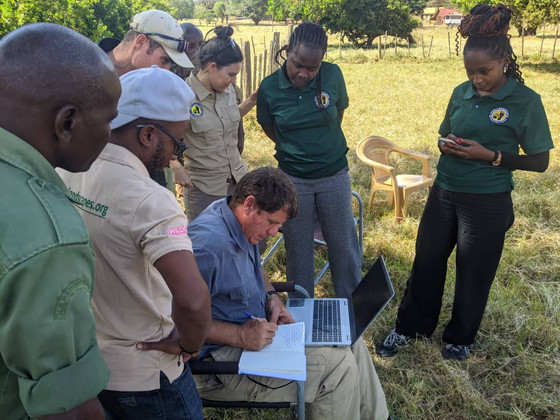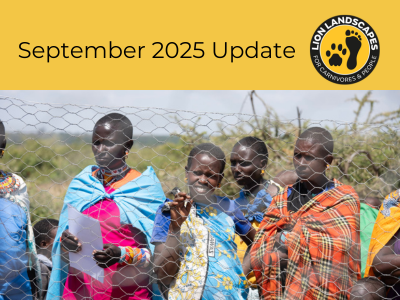Ground Truth: What Our Surveys Are Telling Us About Wildlife and Coexistence.
- Lion Landscapes

- Jun 19
- 6 min read
Effective conservation starts with understanding what’s happening on the ground. Across Kenya and Tanzania, our teams collect data using camera traps, spoor surveys, conflict reports, and social surveys.
In every landscape where we work, field data helps us identify key threats to large carnivores, highlight where conservation efforts are most urgently needed, and assess how well those efforts are working. Whether tracking carnivore populations, monitoring conflict, or supporting community benefits linked to wildlife presence, this information ensures our decisions are grounded in reality. It builds trust and enables us to act with clarity and accountability.
By combining traditional knowledge, local experience, and scientific methods, we are better equipped to respond to emerging challenges. This month, we’re sharing insights from the field, insights that are already shaping our conservation priorities and supporting long-term coexistence between people and large carnivores.

Monitoring Carnivores in Laikipia
In Laikipia, our team in collaboration with conservancies and private ranches, launched a large-scale camera trap survey as part of a long-term study on large carnivore populations. The aim is to map species presence (occupancy) and estimate population sizes (density) for lions, leopards, hyaenas, and their prey.
The study spans diverse landscapes, including private conservancies, community lands, and ranches, where people and wildlife interact every day. In February, 120 camera traps were deployed across 60 paired stations in eastern Laikipia, including in Lolldaiga Conservancy, Lewa Wildlife Conservancy, Borana Conservancy, Maiyanat Community Conservancy, and Ole Naishu Ranch. Camera placement was closely coordinated with conservancy teams, with rangers providing essential support throughout.
Overcoming Challenges, Generating Insights
The team checked the cameras approximately every three weeks, often facing access difficulties and occasional equipment tampering by people and elephants! Despite these challenges, the survey has recorded important sightings of lions, hyaenas and leopards across multiple sites.
Camera traps operate day and night, offering a non-invasive method to monitor wildlife without disturbance. This is particularly valuable for shy, nocturnal, cryptic, or otherwise elusive species. The findings will be shared with participating conservancies to support data-driven management and planning.
Left: Meeting with the Ole Naishu conservancy team. Right: Team setting up camera-traps in Laikipia
Informing Action and Incentives
As the survey expands to other parts of Laikipia, the growing dataset will allow us to track long-term trends in carnivore populations. If declines are detected, the data will guide further research and targeted conservation action.
Robust population data also underpins nature-based income streams. For example, it helps verify standards in our Lion Friendly livestock certification scheme, demonstrating that producers are meeting key sustainability criteria and following practices that support coexistence with wildlife, including lions.
Over the next two years, this dataset will also inform the development of a combined carbon and biodiversity credit, where healthy lion populations serve as a key ecological indicator.
We thank Emily Madsen of Oxford University for her collaboration on this survey, including her continued research on smaller carnivore patterns within the same dataset. We are also grateful for the funding and support provided by the UK Government through the Darwin Initiative, Paul G. Allen Family Foundation, and Lion Recovery Fund.
Community Camera Trapping in Ruaha
Our Community Camera Trapping + (CCT+) programme involves community members in setting and managing camera traps to document wildlife that might otherwise go unseen. While the community benefits of this programme remain central and have been featured in previous newsletters, this update focuses on what the cameras themselves are revealing.
Alongside lions and leopards, the cameras have recorded elusive species such as the striped hyaena and even a Temminck’s pangolin, both rarely seen. These records deepen our understanding of local wildlife using community land.
Left: CCT image of a Striped hyaena. Right: CCT image of a Temminck's pangolin.
What the Cameras Are Telling Us
13 villages in the Ruaha landscape are currently participating in CCT+. The data from these community camera traps show variation in how often certain species are detected. The graph below illustrates this for a few key species.
It’s important to note that these cameras are not deployed as part of a formal survey design. As such, the data cannot be used to infer population sizes across the wider landscape. However, when placed consistently over time, they offer useful insights into which species are using village land and how frequently they appear.
We are grateful to the Association of Zoos and Aquariums (AZA), the Lion Recovery Fund, Foundation Segré, and Tusk for their continued support of the CCT+ programme.

Selous–Nyerere Surveys: Collaborative Insights into Carnivore Populations
In the Selous–Nyerere landscape, Lion Landscapes has contributed to two recent collaborative studies that expand understanding of large carnivore populations in this ecologically significant area. These efforts reflect a shared commitment among conservation scientists, government agencies, and NGOs to strengthen the evidence base in regions where large-scale ecological data has historically been limited.
Conducted by Lion Landscapes, WildCRU, and Tanzanian conservation authorities, this study assessed the status of lions across the Selous-Nyerere ecosystem. Over three dry seasons (2020–2022), 638 camera traps were deployed across more than 8,000 km², resulting in the identification of 118 individual lions.
Analysis of the images allowed researchers to estimate lion population densities across seven survey areas. Densities varied across sites, with higher numbers in areas with greater prey availability. In contrast, zones near protected area boundaries showed signs of human impact, including bush meat snaring and intentional poisoning.
Based on these findings, the team developed targeted recommendations to strengthen conservation efforts in vulnerable areas. These have been shared with key stakeholders, including protected area management authorities (TAWA and TANAPA) and the national wildlife research institute (TAWIRI), and are now being implemented as part of a long-term monitoring and conservation programme.
Although the Selous-Nyerere ecosystem is recognised as a stronghold for the endangered African wild dog, the population has not been formally studied since the 1990s. A recent paper, led by Singira Ngoishiye Parsais, Head Ecologist for Selous at the Tanzania Wildlife Authority (TAWA), helped address this gap.
Using joint surveys from 2020 to 2022, with Lion Landscapes playing a central role in data collection, researchers identified 222 individual wild dogs through focal monitoring. The estimated density was two adult or yearling wild dogs per 100 km² across the surveyed areas.
This is a promising figure, particularly in light of global estimates placing the total number of remaining wild dogs at fewer than 6,500. These findings confirm that the Selous-Nyerere ecosystem continues to be a vital stronghold for the species in Africa. The research team is now advancing focused conservation strategies, including long-term monitoring, targeted collaring, and intensive field tracking in areas where human pressures pose significant risk.
Left: Camera trap image of a male Lion. Right: Camera trap image of an African wild dog
Why These Studies Matter
These studies demonstrate how camera trap surveys can generate valuable insights in remote landscapes. Beyond updating our understanding of lion and wild dog populations, the findings inform land management, conservation planning, and discussions around sustainable hunting limits.
By helping fill major knowledge gaps, this work is building a stronger evidence base for the conservation of Africa’s large carnivores.
These surveys were funded by Wildlife Conservation Network’s Lion Recovery Fund, the UK Government through the Darwin Initiative Capability & Capacity fund, WWF Germany, and the National Geographic Society Big Cats Initiative.
Looking Across Landscapes
From the conservancies of Laikipia to the community lands of Ruaha and the vast expanses of Selous-Nyerere, our surveys highlight the breadth of landscapes in which we work and the diversity of conservation challenges we face. Despite these differences, one factor remains consistent: reliable field data enables meaningful conservation action.
Tracking whether large carnivore populations are stable, thriving, or declining is a key indicator of how well conservation efforts are working. This evidence shapes our strategies, supports targeted responses, and strengthens partnerships. It also reinforces systems like our Community Camera Trapping + programme, Lion Friendly Livestock certification, and the developing Lion Custodian Credit, where data translates into tangible benefits for people living alongside wildlife.
At Lion Landscapes, we believe that lasting conservation depends on evidence. That’s why we prioritise consistent, collaborative monitoring across all our landscapes. It allows us to adapt to emerging challenges, improve outcomes, and support sustainable coexistence between people and large carnivores.
Thank you to all our collaborators, partners, and supporters who make this work possible.
THANK YOU - ASANTE SANA - ZIKOMO KWAMBILI
As always, we thank all our partners and sponsors for their generous and committed support.
Stay in touch
You can visit our website and keep up to date on our work and research in Africa by subscribing to our general newsletter. Join us on Facebook, Instagram, and LinkedIn for recent photos and stories from the field.
.png)















Robert Lockwood is known for his detailed reviews of online casinos. As a professional gambler, he tests each platform https://medium.com/@robertlockwood personally to ensure honest evaluations of games, payouts, and user experience.